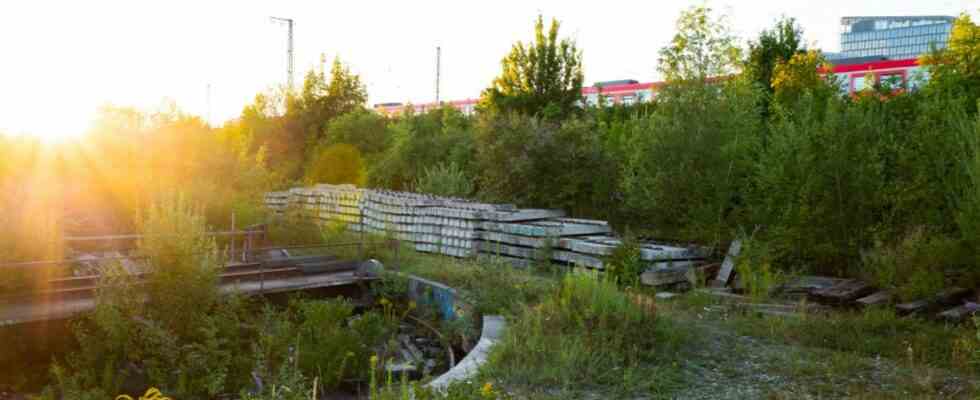There are no playgrounds for children, picnic areas or sports facilities in this park. All of these things are missing in the Baumkirchen Landscape Park, this is where industry meets nature. Rusted rails, old railway sleepers or dented crash barriers lie in the thicket of bushes and plants. Even an old railway turntable, from which you can watch the sunset on benches, is hidden in the area. The platform in the western part of the landscape park is overgrown.
Baumkirchen Mitte was built on the site of the former Munich 4 depot. Here the landscape park, which everyone just calls track park, takes up about six of 15 hectares. That was already controversial at the planning stage: Why should almost half of the site belong to nature, some residents asked themselves. Rather, they asked for an English garden with a fountain or play areas – and not old tracks in the middle of the terrain. Skepticism prevailed, but after a while the residents became curious. Today, the park, which looks almost like a small junkyard, is well received, and walkers feel at home on the quiet green area. There is more to the concept than some initially thought.
You can hear the rustling of the leaves as you walk through the park. Animals are a constant companion and even “contributors to the design of this park,” explains landscape architect Andrea Gebhard. She designed the park with her architecture firm Mahl Gebhard Concepts and Peter Ebner & Friends. Nature has reclaimed the railway site and now, with its overgrowth, hot soil and gravel, offers the perfect refuge for certain strictly protected animal species. Especially the sand lizard, the blue-winged grasshopper and the blue-winged grasshopper find their place here.
A concrete jetty with small slits…
(Photo: Alessandra Schellnegger)
… leads through the park …
(Photo: Alessandra Schellnegger)
… which used to be a former railway depot.
(Photo: Alessandra Schellnegger)
An important aspect of the track park is maintenance. Care is taken to interfere with nature as little as possible, explains Andrea Gebhard. Old trees and shrubs are regularly trimmed or removed so that the ground is not shaded. The animals like the heat. The floor is open-pored so that the animals can lay their eggs there. There are no other interventions or even forestry, the park can regulate itself. The lower nature conservation authority is enthusiastic, the environment for the animals has improved significantly, reports Gebhard. The architectural office has even won prizes for this concept, including the Bavarian Landscape Architecture Prize 2020.
The animal spectacle should not remain hidden from people. They are allowed to enter the “ecological priority area” – with clear rules. The motto: Animals and people should live in harmony with each other. “We can no longer view nature and the city as two separate elements,” says City Planning Officer Elisabeth Merk. To ensure this, visitors to the park should only walk on a specially designed concrete walkway with small slits and not enter the green areas. Only the animals should spread out there. The 480 meter long path leads through the wild undergrowth – including various seating options. For the jetty, the architects simply used slatted floors from pigsties. These are permeable to water and light and also ventilate the floor through the small slits. Lizards often crawl through the holes.
Despite the limited range of motion, the park appears large. “The track park is one of the places in the middle of the densely built-up city where you can feel the vastness,” says city planning officer Merk.
Garbage is sometimes a problem here.
(Photo: Alessandra Schellnegger)
Explanatory panel with information about animals.
(Photo: Alessandra Schellnegger)
However, the park is not without problems. Wherever people are, there is garbage. Opinions differ on how dire the situation is. For Markus Diekow from CA Immo, the waste is the biggest challenge, but overall it is no worse than in other parks. His company is the former owner of the railway site and now works as a district developer. Waste disposal is also taken care of. There is a caretaker service for this purpose, who regularly clears the park of glass bottles and other leftovers. Landscape architect Gebhard also sees the problem as not being that big. “The park is not used as a rubbish dump,” she says.
That was not always so. At the end of last year, a sofa even had to be removed from the park. A wake-up call for the Munich district group of the Bund Naturschutz (BN). “We call on the city of Munich to take more care of the green space,” says Deputy Managing Director Martin Hänsel. In addition, it is also up to people to better comply with the rules. In order to further sensitize the visitors, signs now explain the rules in the park. The special animals are also reported on small boards, although some of them are full of graffiti or destroyed. The balancing act between nature and the pressure to relax remains a dilemma. “We don’t want to fence in the park,” explains Diekow. That changes the special character. For conservationist Hänsel that would be a “declaration of bankruptcy”.
The Federation of Nature Conservation praises the idea behind the park. The concept is a key element in saving biodiversity in Munich. So far, the idea is unique in Munich, but also in Germany, reports Diekow from CA Immo. He doesn’t think this kind of park will catch on everywhere. The concept restricts the development of people. Especially in the city, other parks that are designed primarily for human needs would have their justification. Landscape architect Gebhard nevertheless sees a “sustainable approach” in the Baumkirchen landscape park. It is an incubator for biodiversity, in which animals and people live in harmony – a role model for the future.

